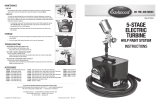
5. OPERATION
5.1. Mask the area which is NOT to be painted.
5.2. Ensure the object to be painted is free from dust, grease and the surface has been prepared.
5.3. After mixing and thinning the paint, as instructed by the paint manufacturer, fill the paint jar (fig.1.2) just over half full. Note:
Mix thoroughly, making sure that the paint is free from lumps. It may be necessary to strain the paint first.
5.4. Remove the nozzle end cap. (fig1.1) No nozzle end cap fitted (fig2.1).
5.5. Turn the air ON and test your spray on a test panel to get the “feel” of your air brush.
5.6. Make any necessary spray adjustments. The paint spray pattern can be adjusted by turning the fixing nut, located at the nozzle. The
nut is fully closed, when it has been turned clockwise to the stop point. The volume of paint dispensed can be adjusted by varying the
backward movement of the trigger (fig.1.4). This can be pre-set using the micro adjust screw (fig.1.5).
5.7. Holding the air brush about 6 inches from the surface press the trigger (fig.1.4) down. Using short strokes, move the air brush at a
steady rate, parallel to the surface, (fig.3.)
5.8. Apply a light coat of paint, let it dry, then apply another coat. Continue with this method until the desired coverage is reached.
DO NOT spray too heavily. Note: When using quick drying paints, it is advisable to clean or immerse the fluid end of the air brush in a
compatible solvent between sprays.
5.9. Once you are satisfied with the results of your test pieces and have made any necessary adjustments to the air brush, continue with
the task to be performed. Best results are achieved with a good constant motion. Start the motion before pressing the trigger
and follow a through motion after releasing the trigger, (fig.4.)
6. CLEANING & MAINTENANCE
6.1. Note: To achieve the best results when spraying it is always best to start with the air brush clean and totally free from old paint
deposits, dirt etc. Therefore the air brush should be thoroughly cleaned immediately after each operation.
6.2. Remove the empty paint container, wipe the inside thoroughly, including the lid.
6.2.1. Fill the container half full of a compatible solvent and re-attach to the air brush.
6.2.2. Spray into a suitable container, this will clean the needle and nozzle assembly. Hold a soft cloth over the fixing nut and spray again,
this will force air and the compatible solvent back through the air brush and clean the internal moving parts.
6.3. Should the air brush become clogged with paint, dismantle the air brush and clean the component parts as follows:
6.3.1. Turn off the air and disconnect the air hose from the air brush.
WARNING! The fluid needle has a long sharp point and great care should be exercised when handling it.
6.3.2. Unscrew the back casing from the main body of the air brush and slide it off.
6.3.3. Unscrew the needle fixing screw and slide it off the needle. Carefully withdraw the fluid needle and place it somewhere safe
to avoid bending it or damaging the sharp point.
6.3.4. Unscrew the fixing nut from the front of the air brush.
6.3.5. Loosen the nozzle assembly with the wrench provided and unscrew it. If the nozzle needs to be soaked in solvent remove the ‘O’
ring as it may be damaged by the solvent.
6.3.6. Unscrew the needle guide assembly from the rear of the air brush body. Test the action of the sprung plunger. If this operates smoothly
no further disassembly is required.
6.3.7. The trigger and curved lever will now be loose in the body and should be removed.
6.3.8. Any components with dried paint on them should be cleaned with a solvent suitable for the paint last used and may need to be soaked
for a while before the paint will come off. Take great care not to bend the needle when cleaning it and avoid the sharp point.
6.4. Reassemble the cleaned air brush as follows:
6.4.1. Replace ‘O’ ring onto the nozzle assembly and screw nozzle into place on body. DO NOT over tighten as this may restrict the
effectiveness of the spray pattern.
6.4.2. Position the trigger into the opening in the top of the air brush so that it sits on top of the air valve. The slot in the stem of the
trigger should be orientated to allow the needle to pass through it when the needle is reinserted.
6.4.3. Insert the curved lever into the rear opening of the air brush body such that the convex face of the
upper section rests against the trigger.
6.4.4. Screw the needle guide assembly into the back of the air brush until it makes contact with the curved lever.
Continue to screw it in until the trigger moves forwards and makes contact with the air adjustment screw.
6.4.5. Carefully insert the needle into the needle guide assembly and push it through until the needle tip just emerges from the nozzle
assembly. DO NOT force it into position but allow the needle to ‘rest’ in place.
6.4.6. Slide the needle fixing screw over the end of the needle and screw it into the rear of the needle guide assembly.
6.4.7. Test the action of the trigger to ensure that the needle withdraws smoothly into the nozzle as the trigger is pulled back.
6.4.8. Screw the fixing nut onto the nozzle. DO NOT do it up too tightly. Screw the back casing onto the back of the air brush body.
fig.3
Original Language Version
© Jack Sealey Limited AB936 Issue:2 (H,F) 14/03/22
fig.1fig.2
KEEP AIR BRUSH
PARALLEL TO SURFACE
START
MOTION
HERE
PRESS
TRIGGER
HERE
RELEASE
TRIGGER
HERE
KEEP MOTION
STEADY AND SPRAY
FOLLOW
THROUGH
MOTION
SURFACE fig.4





